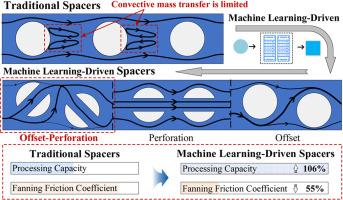通过机器学习驱动的偏移射孔柱节点间隔器优化膜模块中的气体传质途径
IF 9
1区 工程技术
Q1 ENGINEERING, CHEMICAL
引用次数: 0
摘要
膜组件中进料间隔器的设计是抑制进料侧浓度极化和提高气体分离性能的关键。然而,在解决流动分布不均和传质增强不足方面仍然存在挑战,特别是对于高性能膜。为了克服这些限制,本研究提出了一种新的隔离器设计,利用偏置射孔柱节点隔离器优化流道。模拟了进料侧流场,阐明了邻井和射孔构型下的传质机理和能量耗散途径。穿孔策略减少了对称涡区,降低了范宁摩擦系数。这种现象的发生是由于对流传质途径的延长,从而增加了主流区和膜表面之间的传输过程。偏置策略在增加对流传质途径的同时破坏了流动的对称性,从而提高了传质效率。最后,利用机器学习参数建立了一个模型,预测包括射孔角在内的五个结构参数对范宁摩擦系数和膜模块处理能力提高的影响程度。最佳结构应结合隔离丝直径(0.6-0.8倍通道高度)、射孔角度(60°-70°)、射孔直径(0.25-0.35倍通道高度)和偏移距离(0.7-0.8倍间隙距离)。通道高度根据工艺要求确定,以实现高效传质和低能耗之间的平衡。本文章由计算机程序翻译,如有差异,请以英文原文为准。

Optimizing gas mass transfer pathways in membrane modules via machine learning-driven offset-perforation column node spacers
The designation of feed spacers in membrane modules is crucial for suppressing feed-side concentration polarization and enhancing gas separation performance. Nevertheless, challenges persist in addressing uneven flow distribution and inadequate mass transfer enhancement, especially for the high-performance membranes. To overcome these limitations, this study proposes a novel spacer design with optimized flow paths utilizing offset-perforation column node spacers. The feed-side flow field was simulated to elucidate mass transfer mechanisms and energy dissipation pathways in offset and perforation configurations. The perforation strategy results in a reduction of symmetric vortex regions and a decrease in the Fanning friction coefficient. This phenomenon transpires due to the elongation of convective mass transfer pathways, thereby augmenting the transport process between the mainstream zone and the membrane surface. The offset strategy disrupts flow symmetry while increasing convective mass transfer pathways, thereby improving mass transfer efficiency. Finally, a model was established using machine learning parameters to predict the extent to which five structural parameters—including perforation angle—contribute to improvements in the Fanning friction coefficient and membrane module processing capacity. The optimal structure should combine the spacer filament diameter (0.6–0.8 times the channel height), perforation angle (60°–70°), perforation diameter (0.25–0.35 times the channel height), and offset distance (0.7–0.8 times gap distance). The channel height is determined based on process requirements to achieve a balance between efficient mass transfer and low energy consumption.
求助全文
通过发布文献求助,成功后即可免费获取论文全文。
去求助
来源期刊

Journal of Membrane Science
工程技术-高分子科学
CiteScore
17.10
自引率
17.90%
发文量
1031
审稿时长
2.5 months
期刊介绍:
The Journal of Membrane Science is a publication that focuses on membrane systems and is aimed at academic and industrial chemists, chemical engineers, materials scientists, and membranologists. It publishes original research and reviews on various aspects of membrane transport, membrane formation/structure, fouling, module/process design, and processes/applications. The journal primarily focuses on the structure, function, and performance of non-biological membranes but also includes papers that relate to biological membranes. The Journal of Membrane Science publishes Full Text Papers, State-of-the-Art Reviews, Letters to the Editor, and Perspectives.
 求助内容:
求助内容: 应助结果提醒方式:
应助结果提醒方式:


